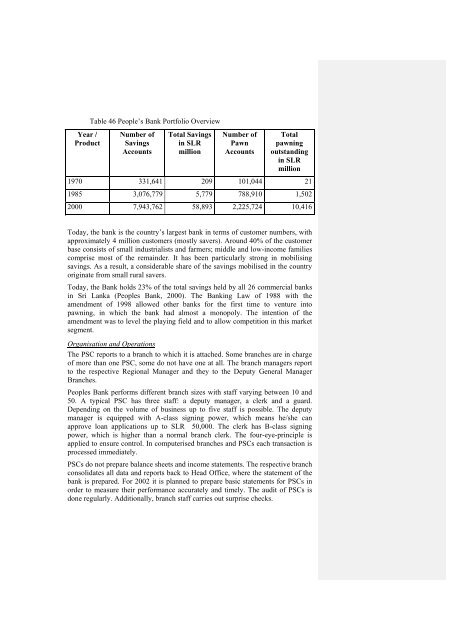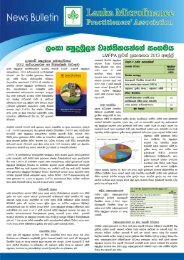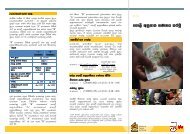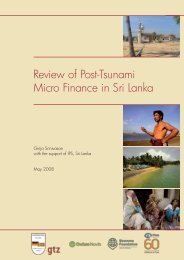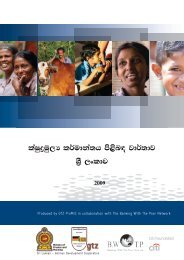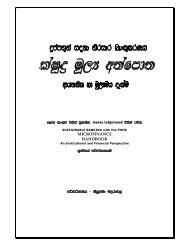National Microfinance Study of Sri Lanka: Survey of Practices and ...
National Microfinance Study of Sri Lanka: Survey of Practices and ...
National Microfinance Study of Sri Lanka: Survey of Practices and ...
Create successful ePaper yourself
Turn your PDF publications into a flip-book with our unique Google optimized e-Paper software.
Year /<br />
Product<br />
Table 46 People’s Bank Portfolio Overview<br />
Number <strong>of</strong><br />
Savings<br />
Accounts<br />
Total Savings<br />
in SLR<br />
million<br />
Number <strong>of</strong><br />
Pawn<br />
Accounts<br />
Total<br />
pawning<br />
outst<strong>and</strong>ing<br />
in SLR<br />
million<br />
1970 331,641 209 101,044 21<br />
1985 3,076,779 5,779 788,910 1,502<br />
2000 7,943,762 58,893 2,225,724 10,416<br />
Today, the bank is the country’s largest bank in terms <strong>of</strong> customer numbers, with<br />
approximately 4 million customers (mostly savers). Around 40% <strong>of</strong> the customer<br />
base consists <strong>of</strong> small industrialists <strong>and</strong> farmers; middle <strong>and</strong> low-income families<br />
comprise most <strong>of</strong> the remainder. It has been particularly strong in mobilising<br />
savings. As a result, a considerable share <strong>of</strong> the savings mobilised in the country<br />
originate from small rural savers.<br />
Today, the Bank holds 23% <strong>of</strong> the total savings held by all 26 commercial banks<br />
in <strong>Sri</strong> <strong>Lanka</strong> (Peoples Bank, 2000). The Banking Law <strong>of</strong> 1988 with the<br />
amendment <strong>of</strong> 1998 allowed other banks for the first time to venture into<br />
pawning, in which the bank had almost a monopoly. The intention <strong>of</strong> the<br />
amendment was to level the playing field <strong>and</strong> to allow competition in this market<br />
segment.<br />
Organisation <strong>and</strong> Operations<br />
The PSC reports to a branch to which it is attached. Some branches are in charge<br />
<strong>of</strong> more than one PSC, some do not have one at all. The branch managers report<br />
to the respective Regional Manager <strong>and</strong> they to the Deputy General Manager<br />
Branches.<br />
Peoples Bank performs different branch sizes with staff varying between 10 <strong>and</strong><br />
50. A typical PSC has three staff: a deputy manager, a clerk <strong>and</strong> a guard.<br />
Depending on the volume <strong>of</strong> business up to five staff is possible. The deputy<br />
manager is equipped with A-class signing power, which means he/she can<br />
approve loan applications up to SLR 50,000. The clerk has B-class signing<br />
power, which is higher than a normal branch clerk. The four-eye-principle is<br />
applied to ensure control. In computerised branches <strong>and</strong> PSCs each transaction is<br />
processed immediately.<br />
PSCs do not prepare balance sheets <strong>and</strong> income statements. The respective branch<br />
consolidates all data <strong>and</strong> reports back to Head Office, where the statement <strong>of</strong> the<br />
bank is prepared. For 2002 it is planned to prepare basic statements for PSCs in<br />
order to measure their performance accurately <strong>and</strong> timely. The audit <strong>of</strong> PSCs is<br />
done regularly. Additionally, branch staff carries out surprise checks.


